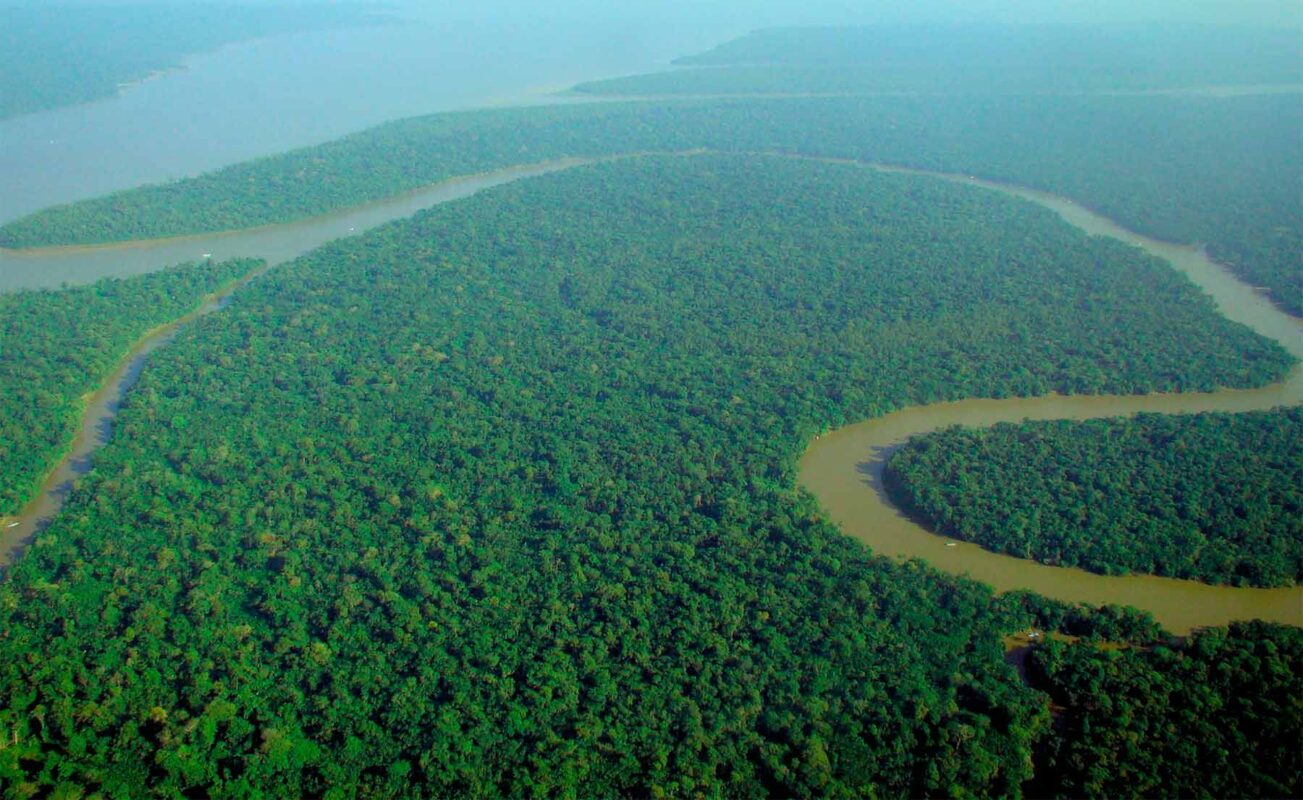
The Amazon Rainforest remains a carbon sink, stashing away 7.6 billion metric tons of carbon dioxide every

The Amazon Rainforest remains a carbon sink, stashing away 7.6 billion metric tons of carbon dioxide every
Global climate is determined by interactions between the atmosphere, ocean, cryosphere (snow and ice cover), biosphere (air), and geosphere (land). The driving energy behind the climate comes from the sun. Sunlight passes through the earth’s atmosphere and strikes the earth’s surface. Most solar radiation is absorbed by the earth’s surface, but about one-third is reflected from the surface in the form of infrared, or long-wave, radiation.
Although some long-wave radiation is lost into space, a portion is absorbed by gases in the atmosphere–principally water vapor, but also carbon dioxide, methane, chlorofluorocarbons, ozone, and other gases. The absorbed energy is reradiated in all directions, with the result that the earth’s surface stays warmer (about 33°C) than it would without such gases. This phenomenon is known as the greenhouse effect.
Any factor that alters radiation that is received from the sun or lost into space will affect climate. So, too, will any factor that alters the redistribution of energy within the atmosphere and between the atmosphere, land, and ocean. Increases in the concentration of the greenhouse gases reduce the efficiency with which the earth cools to space and tend to warm the lower atmosphere and surface–a process known as radiative forcing. Based on sampling of ice cores in glaciers and direct air sampling done since 1958, atmospheric concentrations of certain gases, such as carbon dioxide, methane, chlorofluorocarbons, nitrous oxide, and tropospheric ozone, have been increasing over the past century.
Amongst these gases, carbon dioxide (CO2) is of the most concern with respect to its role in climate change. The carbon dioxide component of the atmosphere has already increased 25% since preindustrial times (1750-1800) and is estimated to be growing at 0.5% per year. Climatologists estimate that the increase in atmospheric carbon dioxide has contributed about 60% of the climate change over the last two centuries. Man-made sources of carbon dioxide derive mainly from burning fossil fuels and deforestation, activities which are not likely to decrease in the near future unless government policies dictate otherwise. And because the level of atmospheric carbon dioxide adjusts very slowly to changes in source, the carbon dioxide emitted today will influence its atmospheric concentration for centuries. Thus, it is urgent to determine the effects of carbon dioxide.
Although greenhouse gases released at the earth’s surface rise into the atmosphere, they do not equally stabilize there. Feedback processes come into effect as concentrations of gases increase. Carbon dioxide, for example, is continuously being absorbed by green plants and by chemical and biological processes in the oceans. The photosynthetic process of plants increases in the presence of higher atmospheric concentrations of carbon dioxide, and therefore could counteract some of the build-up by absorbing more carbon dioxide into the plants. Similarly, because the carbon dioxide content of the oceans’ surface waters stays roughly in equilibrium with that of the atmosphere, oceanic uptake will slow the build-up to some extent.
There are other effects to greenhouse gases; an increase in carbon dioxide induces an increase in water vapor, which would tend to amplify temperatures. A warmer earth would result in less snow and ice cover, which would result in a less reflective planet–one that absorbs more solar radiation. Cloud cover is an extremely complex feedback mechanism; it that can have either positive or negative feedbacks depending on such factors as density, composition, and altitude. Clouds at lower altitudes reflect more sunlight as temperatures increase and are thus assumed to have a negative effect on warming. Higher-altitude clouds, by virtue of absorbing reflected radiation from the earth, can have either a positive or negative effect based on their height and extent of cover. Because both cloud and snow/ice feedbacks are geographical in nature, these feedback mechanisms can only be addressed through the use of three-dimensional mathematical circulation models.
In order to contribute to the reduction of CO2 in the atmosphere and preserve the some of the remaining rainforests in Latin America, the Carbon Sequestration Program was created. The Forest Bird Society will buy or aquire the land through a long term lease for each individual project, therefore reassuring potential investors that the projects will be carried out as planned over time. In order to achieve this objective, the FBS intends work in cooperation with local governments and land owners, because managing these forests will demand planning and resources.
Once an area has been selected as suitable for carbon sequestration, the FBS will develop a project with imput from the local community. Once completed, we will disperse the news in search for potential investors. With their support and as part of the World Innitiative to curb Global Warming, they will in exchange receive carbon reduction benefits related to the amount of CO2 that each project will sequester. This strategy will assure that each project carried out, will have a financed budget during its lifespan.
We are currently working on different types of projects. These range from forest management, reforestation, afforestation and habitat restoration; and all of most of them are suitable for carbon sequestration, depending on how the land is going to be managed. This program is to be implemented in 2002-2003 as the Forest Bird Society launches itself as an aggressive pursuer of Nature Conservation. Thank you for visiting with us.